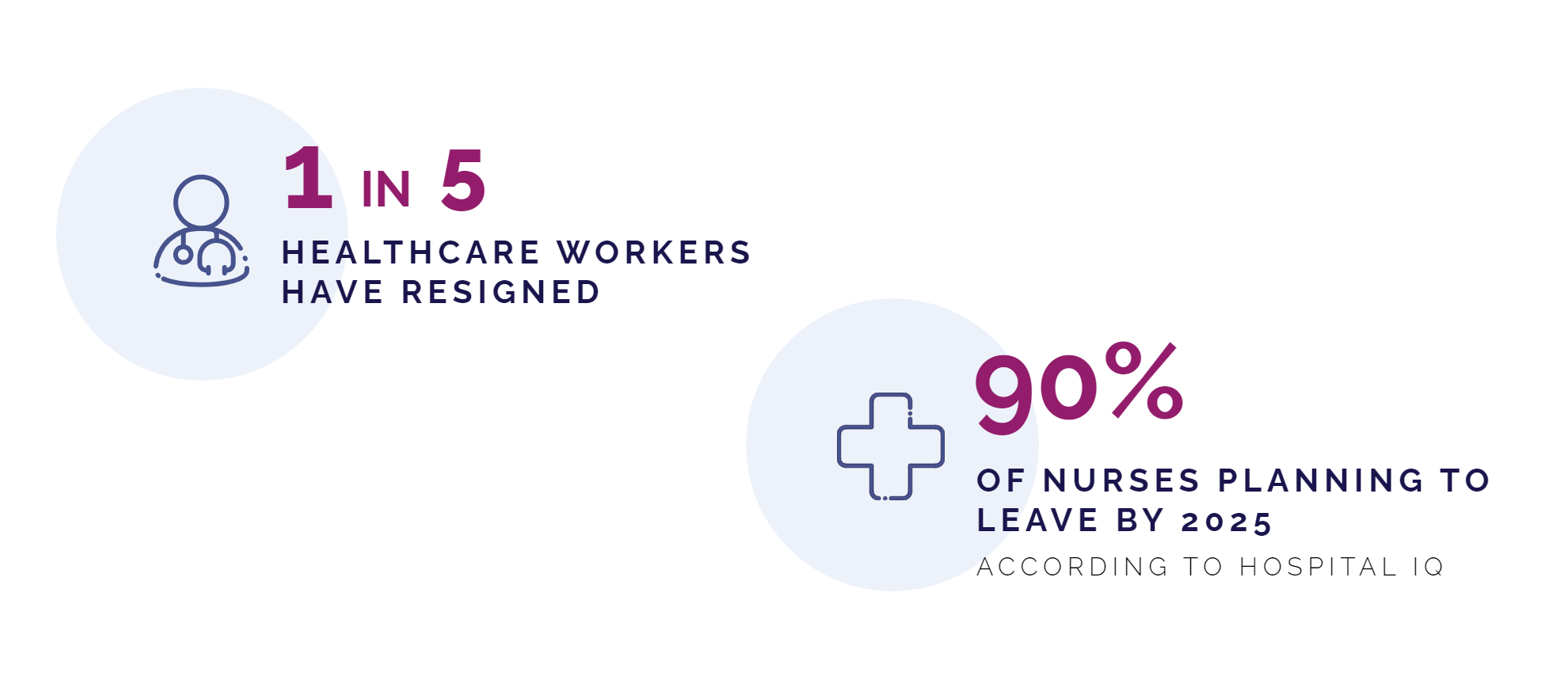Drive Demand while Combatting Workforce Challenges and Improving Care Team Interactions
Written by Lane Wise, Director of Client Outcomes Engineering, ABOUT
Healthcare workers are leaving their jobs – we know it because we feel it. This great resignation has effects on the access center, health system capacity, and care team satisfaction. Since the start of the COVID-19 pandemic, one in five healthcare workers have resigned, and 90% of nurses plan to leave the bedside nurse profession by 2025. Staffing is a long-term problem. We have a strained healthcare system, and there is no slowing down; however, there are a few strategies that will help with your workforce efficiency and care team satisfaction.

Healthcare workers are being asked to “do more with less”
To try and mitigate workforce shortages, we first need to assess why healthcare workers are leaving. Healthcare workers often go into the field because they are passionate and devoted but they are also humans who have a need for work/life balance and support in times of high stress. When these needs are not met, healthcare workers will experience symptoms of burnout.
Staff are being asked to do more with less, which is becoming a challenge considering increased workload and constraints placed on teams. So, what can we do to combat these challenges and improve existing care team interactions and satisfaction? The clinical operations team at ABOUT has identified three key themes to combat these challenges:
1. Optimize your staffing strategies
- Now is the time to reexamine staffing needs. Start looking at your data to see where you may be able to leverage non-traditional shifts. Look at time spent in technology, phone metrics, and patient demand to see where you may be able to shift responsibilities.
- Ensure you are allowing your clinicians to work at top-of-license. In this current workforce shortage, most RNs are needed at the bedside. Think creatively to determine what alternative resources could be available, such as EMTs, paramedics, MAs, LPNs, and CNAs, and evaluate workflows for non-RN tasks. With ABOUT solutions, logistics and operations automation reduces administrative work, increases efficiency, and improves accuracy, enabling clinicians to work at top-of-license while standardizing processes.
- Consider remote working options. Remote operations have become increasingly popular, and employees are starting to expect options in their job searches. Remote work provides flexibility, no commuting, and opportunities to cover partial shifts. Providing this option can create an extended labor pool, but there are some considerations to keep in mind, such as any IT requirements, benefits for out of state workers, trust, and training.
- Make onboarding a priority and as easy as possible. This will likely be a career change for new employees, which means they will want structure. Eliminate complexity, and clearly outline protocols, workflows, and technology. It is also important to elicit frequent feedback, check in to make sure things are going well, and be flexible to make changes if needed.
2. Standardize and advance care team interactions and workflows
- Ensure that your workflows and care team interactions are top of mind. Standardize your access center through the correct workflows. Make sure that each team member understands the workflows and functions the same way – do not leave it up to them to interpret. Think about how team members interact with one another within the health system. Make sure all interactions are meaningful and consistent and optimize them within the workflows. There will always be a change management component to standardizing care team interactions and workflows, so make sure that you are communicating clearly and often.
- Leverage technology and automation to achieve your goals. Utilize interfaces, resource visibility, reduce faxes, and configure phone systems to make sure you are not using outdated technology and processes. One of the biggest areas of opportunity for standardization and optimization in the access center is phone call reduction. If you ask an agent how busy they were, they will give you an answer in numbers of phone calls.
- Make every phone call count, eliminate excess phone calls and phone tag, ensure documentation, and use other tools to reduce the number of calls. ABOUT provides Secure Messaging, which is seamlessly integrated in the ABOUT Orchestration Engine and empowers care teams to efficiently communicate and collaborate to quickly transfer patients for improved outcomes. Additionally, with the ABOUT Bed Visibility product, you can also eliminate phone calls and phone tag by quickly identifying open beds and the right level of care without the need to sign into a bed management system.
3. Reach out and educate internal and external audiences
- Outreach is crucial to increasing demand for your health system. Often, the access center acts as the front door to all services in a health system. It is important to focus on both internal and external outreach to educate audiences about the access center functions and benefits. The access center has impacts to your entire health system. ABOUT can help you deliver strategic and operational decision support with analytics and reporting. Show internal stakeholders key metrics and have open communication to educate them on where they might be able to improve response times, acceptance rates, and overall care to patients. It is also important to get out into your market and have face-to-face interactions with referring providers. This will give you the opportunity to build relationships, hear honest feedback, and improve operations. Utilize analytics and reporting to identify trends, close the loop on any existing issues, discuss outcomes of referrals, and promote service lines.
ABOUT backs technology with partnership by becoming a trusted advisor to ensure health systems’ success.
At ABOUT, our hands-on clinical, operations, and business experts work to understand the health system and market dynamics to become a trusted advisor and provide best practices, change management, and analytics insights.
Ready to learn more? Get started.